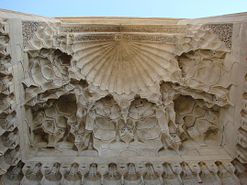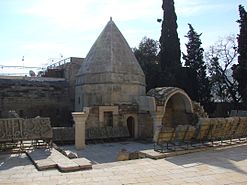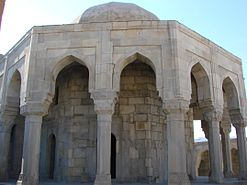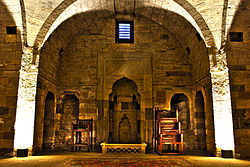| Revision as of 13:27, 1 June 2016 editLouisAragon (talk | contribs)Autopatrolled, Extended confirmed users, Pending changes reviewers, Rollbackers71,887 edits Removed tag, see the abundant discussion on the talk page. Prolonged ignoring of sourcing, prolonged self-made WP:OR theory usage (which Misplaced Pages is not the place for).← Previous edit | Revision as of 14:43, 1 June 2016 edit undoAmamedli (talk | contribs)87 edits Please stop ignoring. I have provided rationale for Azeri coming before Persian. Extensive debate doesn't make this right. We will have to see evidence of Persian being spoken by the Shirvanshahs of that period. Bullying of another user doesn't count.Tag: Visual editNext edit → | ||
| Line 11: | Line 11: | ||
| | Danger = 2003-2009 | | Danger = 2003-2009 | ||
| }} | }} | ||
| The '''Palace of the Shirvanshahs''' ({{lang- |
The '''Palace of the Shirvanshahs''' ({{lang-az|Şirvanşahlar Sarayı}}, {{lang-fa|کاخ شروانشاهان}}) is a 15th-century palace built by the ]s and described by UNESCO as "one of the pearls of Azerbaijan's architecture". It is located in the Inner City of ], ] and, together with the ], forms an ensemble of historic monuments inscribed under the ] of Historical Monuments. <ref>{{Cite web|url=http://whc.unesco.org/en/list/958|title=Walled City of Baku with the Shirvanshah's Palace and Maiden Tower - UNESCO World Heritage Centre|last=Centre|first=UNESCO World Heritage|website=whc.unesco.org|language=en|access-date=2016-05-31}}</ref> The complex contains the main building of the palace, Divanhane, the ], the shah's mosque with a minaret, Seyid Yahya Bakuvi's mausoleum, a portal in the east, Murad's gate, a reservoir and the remnants of a bath house. | ||
| The palace is depicted on the ] of the Azerbaijani 10,000 ] banknote of 1994-2006<ref>. National currency: . – Retrieved on 25 February 2010.</ref> and of the 10 new manat banknote issued since 2006.<ref>. National currency: . Retrieved on 25 February 2010.</ref> | The palace is depicted on the ] of the Azerbaijani 10,000 ] banknote of 1994-2006<ref>. National currency: . – Retrieved on 25 February 2010.</ref> and of the 10 new manat banknote issued since 2006.<ref>. National currency: . Retrieved on 25 February 2010.</ref> | ||
Revision as of 14:43, 1 June 2016
UNESCO World Heritage Site| UNESCO World Heritage Site | |
|---|---|
 | |
| Criteria | Cultural: iv |
| Reference | 958 |
| Inscription | 2000 (24th Session) |
| Endangered | 2003-2009 |
The Palace of the Shirvanshahs (Template:Lang-az, Template:Lang-fa) is a 15th-century palace built by the Shirvanshahs and described by UNESCO as "one of the pearls of Azerbaijan's architecture". It is located in the Inner City of Baku, Azerbaijan and, together with the Maiden Tower, forms an ensemble of historic monuments inscribed under the UNESCO World Heritage List of Historical Monuments. The complex contains the main building of the palace, Divanhane, the burial-vaults, the shah's mosque with a minaret, Seyid Yahya Bakuvi's mausoleum, a portal in the east, Murad's gate, a reservoir and the remnants of a bath house.
The palace is depicted on the obverse of the Azerbaijani 10,000 manat banknote of 1994-2006 and of the 10 new manat banknote issued since 2006.
History
In the 15th century the Shirvanshah dynasty, under Ibrahim I of Shirvan, transferred his capital from Shemakha to Baku following a devastating earthquake. He committed himself to the construction of the "palace". The building is believed to be a memorial complex built around the sacred place of worship (pir) and tomb of Seyyid Yaxya Bakuvi who was a Helwati Sufi saint. The Shirvanshahs were patrons of the Helwati Sufiye order, and Shirvanshah Khalilullah I was buried with his family in the grounds of the palace. Other historians argue that the building was used as the ruler's palace. Both theories suffer from the absence of evidence. It is known that wells inside the grounds of the "palace" were considered to have healing qualities until recent times, as was the hill where the palace was built.
After the Safavid conquest of Baku in 1501, the Sufi order was expelled. Over centuries the "palace" fell into ruin and was known in Baku as Baku Khans palace; this toponym moved into Russian historiography, first cited by Bartold.
Architecture
The main building of the complex was started in 1411 by Shirvanshah Sheykh Ibrahim I. The two-storey building of the palace numbers about 50 dimensions and outlines of the constructions connected with three narrow winding staircases. The big lancet portal directly leads from the courtyard to the second floor, into a high octahedral lodging covered with a cupola. A small, octagonal vestibule behind it connects it with the rest of the lodgings in the palace.

Divankhana is a small stone pavilion. It is inside a small courtyard surrounded by a gallery-arcade on three sides. Pharid pavilion consists of an octahedral hall covered with a stone cupola inside and outside. The well-proportioned high portal of the main entrance is decorated with an ornament and Arabic inscription. The ornament pictures interlacing fig and vine leaves. The portal is decorated with two medallions inside of which there are inscriptions in Kufic Arabic.
The Mausoleum of the Shirvanshahs is rectangular and crowned with a hexahedral cupola that is decorated from outside with multi-radial stars. The inscription on the entrance doorway indicates the purpose of the building: "Khalilullah I, the greatest Soltan, Great Shirvanshah, the namesake of the divine prophet, the defender of the religion ordered to construct this light burial-vault for his mother and son in 839" (1435–1436). On two drop-shaped medallions in the flannel parts of the portal there are inscriptions with the architect's name — Memar Ali (architect Ali).
The Palace Mosque (1430s) is in the lower court of the complex. The laconicism of its prismatic volumes, completed with two slightly pointed cupolas, is shaded by a well-proportioned vertical line of the minaret rising above in the northeastern corner of the building. There are two chapels for prayers in the mosque: a large hall for men and a small hall for women, and a couple of small subsidiary rooms. There is an inscription laid under the stalactite belt of the minaret: "The greatest Soltan Khalilullah I ordered to build this minaret. May Allah exalt the days of his governing and reign. The year of 845" (1441–1442).
Seyid Yahya Bakuvi's Mausoleum is in the southern part of the complex. Seyid Yahya Bakuvi was a royal scholar in the court of Shirvanshah Khalilullah. The mausoleum is octahedral and covered with an octahedral marquee. It consists of ground and underground parts. The upper part of the mausoleum was used to perform the cult rites, and the lower one housed the sepulchral vault. There are three small lancet windows with a stone bar — shabaka on the southern, eastern and western verges of the Mausoleum.
The Shirvanshahs' Palace complex includes the portal of Eastern Gates, the so-called "Sultan Murad's Gate" (1585). It was built within the walls of the citadel later than the other constructions of the complex during Ottoman occupation of 1585-1603. The gates were named by them in honor of Sultan Murad III.
The Palace Bath-house is on the lowest terrace of the complex. It was discovered in 1939 and dates to 17th century. The archaeological excavations exposed a big bath-house consisting of 26 rooms. On the basis of the surviving remains of the walls of the bath-house one can say that its rooms used to be covered with cupolas and the light penetrated through the openings in the cupolas. The bath-house was semi-underground for keeping the heat in winter and the cool in summer.
The Shirvanshahs' Palace complex was declared a museum-reserve in 1964 and was taken under the state protection. Major rehabilitation works took place in 2001 and 2002 under World Bank financing. Minor rehabilitation works are ongoing.
See also
References
- Centre, UNESCO World Heritage. "Walled City of Baku with the Shirvanshah's Palace and Maiden Tower - UNESCO World Heritage Centre". whc.unesco.org. Retrieved 2016-05-31.
- Central Bank of Azerbaijan. National currency: 10000 manat. – Retrieved on 25 February 2010.
- Central Bank of Azerbaijan. National currency: 10 manat. Retrieved on 25 February 2010.
- Бретаницкий Л. С. Зодчество Азербайджана XII-XV вв. и его место в архитектуре Переднего Востока / Главная редакция восточной литературы. — Наука, 1966.. — С. 401. — 556 с.
| World Heritage Sites in Azerbaijan | ||
|---|---|---|
40°21′58″N 49°50′00″E / 40.366149°N 49.833443°E / 40.366149; 49.833443
Categories:









